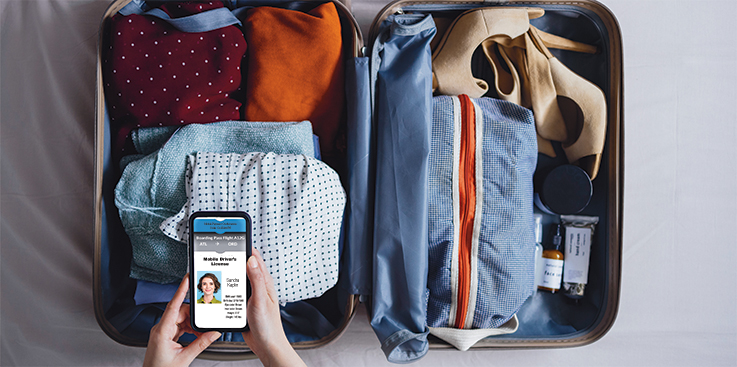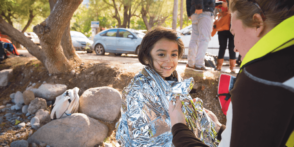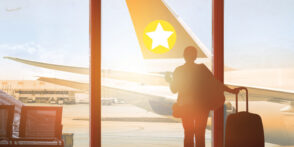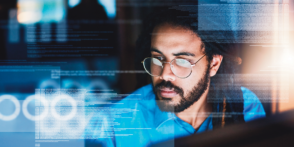Ready for Takeoff
Jurisdictions are aiming to allow mobile driver’s licenses (mDLs) as valid identification for air travel
The world is heading online. The desire for digital over physical documents is becoming the norm—and motor vehicle agencies are embracing the tradition. Several jurisdictions across North America now offer mobile driver’s licenses (mDLs) to their customers, allowing for ease of access and increased security over the physical cards consumers have become accustomed to.
“Jurisdictions started offering mDLs in 2017,” says Mike McCaskill, director of Identity Management at AAMVA, “and pilot programs began back in 2016. Benefits of mDLs are vast: They are more secure, they can be updated in real time and they provide increased privacy for the consumer.”
Moving mDLs forward
New advancements bring innovation, as businesses and government authorities are brainstorming what additional uses there are for mDLs to make customers’ lives easier. What may be the most exciting application that motor vehicle administrators are working on for mDLs is their use as valid ID for air travel.
“When we launched our [mDL] pilot program several years ago, we also surveyed the pilot participants,” says Chrissy Nizer, administrator at the Maryland Department
of Transportation. “The No. 1 reason that people wanted to be able to use a mobile driver’s license was for travel, which we thought was interesting. Depending on your job or how frequently you travel for leisure, it happens maybe several times a year—but it’s certainly not something most people do every day.”
Taking this response to heart, Maryland, along with Arizona and Georgia, have partnered with Apple and the Transportation Security Administration (TSA) to figure out the best way to make this dream a reality.
Nizer says her team has direct contact with Apple and TSA as they work to perfect the user experience and security of Maryland’s mDLs. The goal is to have an mDL available to a consumer with the click of a button, popping up instantly in the Apple Wallet feature on iPhones and iPads. TSA then provides the equipment needed to scan and verify mDLs in the security lines at local airports.
Perfecting the program
With Maryland, Georgia and Arizona “going first” with regard to mDL air travel verification, there is definitely a learning curve. Eric Jorgensen, motor vehicle division director at the Arizona Department of Transportation, says that being an early adopter will benefit others that have yet to begin the process. “As other jurisdictions begin work on allowing mDLs for travel, we’ll have laid the groundwork for their success,” he says.
This goes for other smartphone providers, too. According to a report from Counterpoint
Research, Apple had a 47% share of smartphones in the United States as of Q3 2021—which means that 53% of smartphone users will also need a solution. “Apple is a large provider of smartphones—but they’re not the only one,” Jorgensen says. Google, Samsung and other smartphone providers will likely be hopping on board to provide the service to their users, too.
Ensuring a smooth user experience is another high priority for Jorgensen and Arizona. “Apple has a great user experience team,” he says. “They’re trying to make sure the customers are easily able to enroll their mDL into the Apple Wallet and that each jurisdiction can easily verify the authenticity of the mDL information, as well.”
Support for success
While there are many moving parts and several stakeholders involved in the project, it is important to remember that this is a team effort, with all entities supporting each other through implementation. The jurisdiction, Apple and TSA all need to be constantly communicating to make sure user information is properly verified.
AAMVA has been instrumental in championing the initiative, too, with mDL support dating back a decade. The AAMVA Joint mDL Subcommittee helped develop the functional requirements used to create ISO standards for interoperability between jurisdictions. The ISO 18013–5, published in September 2021, gives motor vehicle administrators a road map to ensure their mDLs are compliant and can be accepted as valid ID both federally and in other jurisdictions.
“[AAMVA] is also creating its Digital Trust Service,” McCaskill says. “The Digital Trust Service will be the one-stop shop for relying parties to obtain the public keys from verified issuing authorities, establishing trust in the mDL with which they are interacting.”
Going public
Both Arizona and Maryland plan on having their mDLs ready for consumers in early 2022, and in the meantime are determining the best way to craft messaging for how to obtain and use the mDL for travel.
“We’re working with both Apple and TSA to make sure we have the right message at the right time,” Jorgensen says. “We don’t want to do it too early—we don’t want to lose that message and have everybody forget [about mDLs] and have to go through the process again. We need to have the proper media exposure in place to inform customers.”
Nizer says Maryland has similar plans regarding marketing mDL opportunities to the public. “We are partnering very closely with Apple to notify customers when this service is available,” she says. “There will also be information on our website detailing how to initiate the mobile driver’s license. So, it will be a partnership as we look at educating the public so that they understand how to go about acquiring and using it.”
Visit aamva.org/topics/mobile-driver-license for guidance and resources relating to mDL implementation.
Listen to our podcast about Arizona’s mDL pilot program at tinyurl.com/AZmobileDL.




